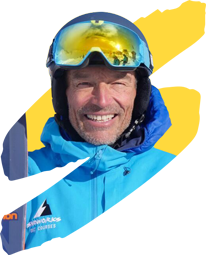
First Steps To Freeriding
Phil Smith, director of Snoworks Ski Courses in a series of articles for InTheSnow talks about Freeriding. In this first article ‘First Steps To Freeriding’.
Go direct to InTheSnow magazine
Photo: Polly Baldwin Dynamic Pictures
You’ve seen it on the films and everyone’s talking about it and wanting to do it – Freeride. What exactly is it and what do you need to be able to do it. In this article we talk about your first steps to freeriding.
YOU’LL NEED TO KNOW WHAT IT IS
Firstly the name says it all. It’s ‘free’, free as in free from restrictions. Wow, that means you can develop your own style. Yes you’ve got it. No more having to face your ‘shoulders to zee valley’ and and no more worrying about not ‘sticking zee bottom out’. You can literally ski however you wish and even better you can ski with your feet as wide or as close as possible without anyone saying this or that is wrong. If someone says you have to ski like this or that then it certainly is not free so expect instruction to be different. It’s more centered around getting down in control, having fun and embracing the snow and the mountains and learning safety in off-piste. You certainly shouldn’t be standing in a line watching a beautiful demonstration from an instructor waiting for your turn and trying to copy him or her. No, it’s enjoy, have fun and develop your own style. You can say goodbye to skiing robotics and hello freedom.
YOU’LL NEED PLANKS
Next comes the equipment – Skis. We’re talking wide, so wide they can look like a pair of water skis. The idea is to get those skis ‘riding’ hence the second part of the name ‘ride’. You ride the snow, not turn in it. If you’ve waterskied, surfed, windsurfed, kitesurfed or skateboarded you’ll know what I mean. The skis form a platform against the snow and it’s the reaction of the snow against the base of the skis that causes them to deflect, not like on a piste where your using edges so skis can be narrow. Freeriding is about using the base so they need to be wide. Ideally we’re looking at least over 100mm underfoot with big shovels.
DON’T BE A BILLY NO MATES
Before you get carried away with fat skis and the feeling of being free and jumping of the nearest precipice the most important thing to remember is off-piste skiing is dangerous, really dangerous, so get educated and I mean well educated. You’re moving away from prepared runs and into off-piste. Avalanche is a real threat. You need the right guidance and the right knowledge from the beginning. We’ll be talking about this in much more detail in future articles. Book on a freeride course or hire a local guide or instructor. This I cannot stress enough. Powder is addictive and addiction can cause errors.
GET YOUR KIT ON
You’re also going to need more than just a pair of fat skis. You’ll need safety equipment and also know how to use it. That’s a minimum of a backpack, shovel, probe and avalanche transceiver and these days an airbag is advised. Time is well spent here. Far too many people kit themselves up and head off with no idea how to use the kit and no idea about safety, so get trained up and book on a course. Again we’ll be talking more about this along with other useful freeriding kit in future articles.
BIN THE DOUGHNUTS
So are you ready? Well maybe not quite. There’s one more thing, you need to be fit. Safety is a big issue here and if you’re heading into the off-piste that means you need to be capable of moving around, getting up after a fall, finding your skis, getting them back on in deep snow. There can also be a lot of hiking involved in order to access runs at the top or exit them at the bottom so start training now and good luck.
_________________________________________________________________________________________
Phil Smith is founder of Snoworks All-Mountain Ski Courses. Snoworks run Off-Piste and Backcountry courses throughout the winter along with Off-Piste Adventure trips to destinations around the world. For more details go to:
www.snoworks.com
